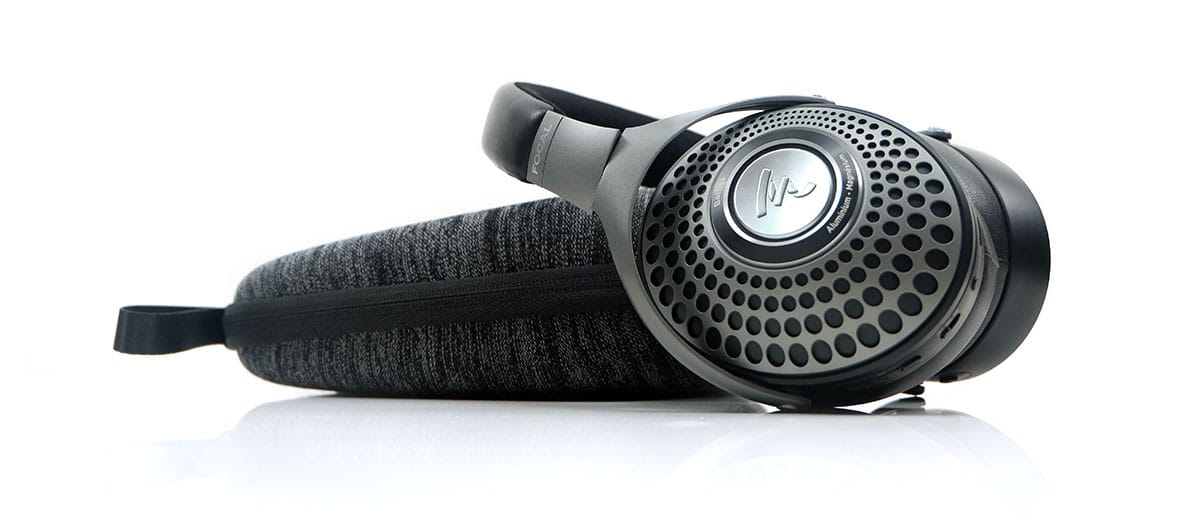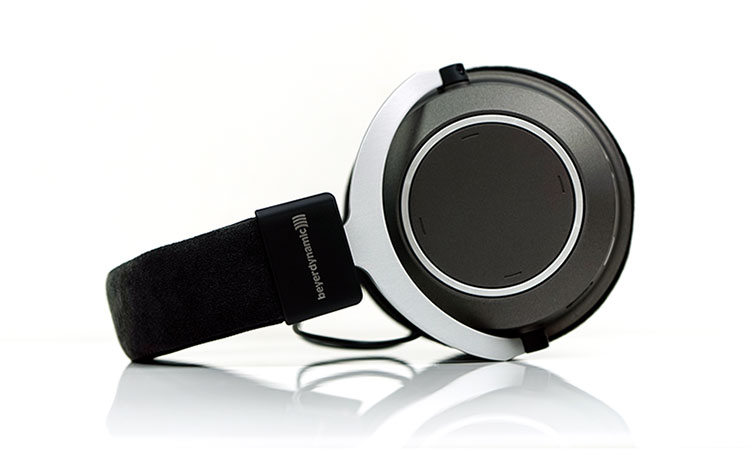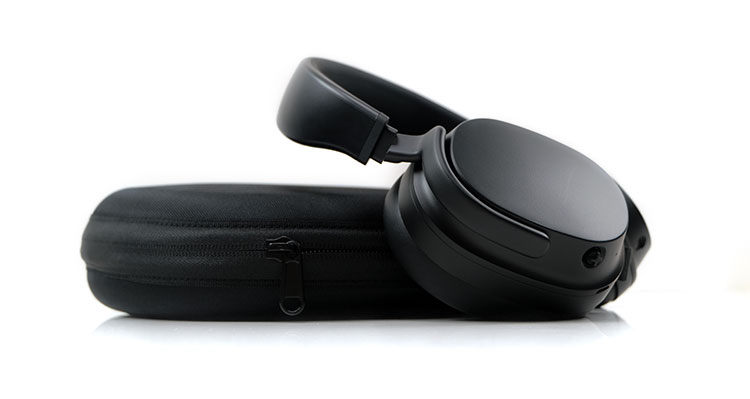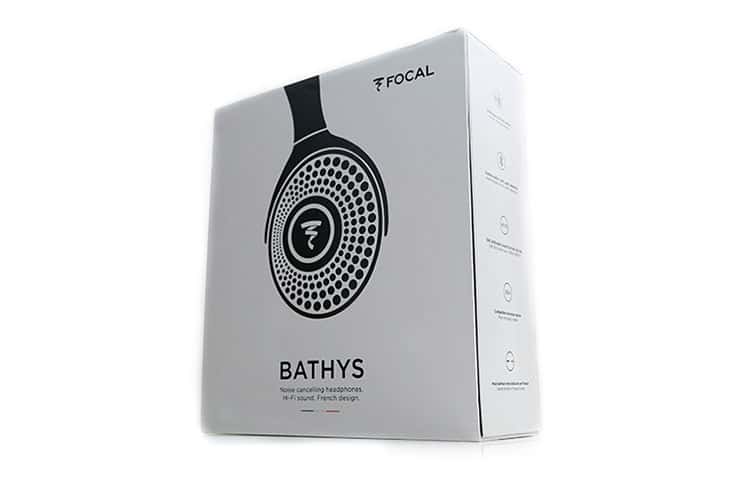Select Comparisons
All comparison work here was based on their wireless performance and completed using a HiBy R8 as our main BT source.
Unfortunately, Mike reviewed the Mark Levinson No. 5909 headphones which would be an ideal comparison so if I get a chance to bring them to the HQ and compare them both I will add a new section here.
HIFIMAN Ananda BT
$999 (Currently $799)
The Ananda BT is the only dedicated wireless headphones in the HIFIMAN lineup and is currently priced the same as the Bathys. All other HIFIMAN headphones use the detachable wireless Bluemini module. You can read our full review of the Ananda BT here.
Technical
Both are BT wireless-equipped, both can operate in USB-DAC but not passive by design, and both are full-sized headphones. That is about it for immediately identifiable similarities.
The differences though are equally obvious with the Bathys a closed-back dynamic driver headphone, (40mm aluminum-magnesium), and the Ananda BT an open-back planar driver design using HIFIMAN’s classic Neo “supernano” diaphragm or NsD for short. Two very different driving principles with hugely contrasting acoustical approaches, Open versus closed).
Digging into the wireless side there are some differences here also. The HIFIMAN version that is integrated here has morphed into the separate Bluemini module and gone R2R for its DAC though that is not the case here for the Ananda BT.
Unfortunately, Focal is less revealing about the internal topology of the Bathys but we do know both companies have the headphones set up for active audio only so neither will work in a purely wired passive mode. All analog signals will go via the internal amplifier of both headphones.
The Bathys is BT5.1 multi-point though it does not have LDAC decoding capability going up to aptX Adaptive and 24BIT/48kHz maximum. The Ananda BT is not multi-point, and a grade lower for BT at BT5.0 but does offer LDAC and can decode wirelessly up to 24BIT/96kHz. Both have a USB-DAC decoding capability of up to 24BIT/192kHz.
Design
Granted, the Ananda BT is wireless and comes with a carry case so there is a degree of portability to it. However, with it lacking ANC and using an open-back design its pitch is more for portability and ease of use inside the home or office or wherever it’s quiet.
The Bathys is much more the high-end travel headphone with its smaller form factor, lighter also at 350g versus 460g, and of course, offering ANC with a closed-back design. The distinction in usage scenarios is really very clear here.
Also, the finishing of the Bathys is more robust with a much simpler yet no less attractive design that can fold flat and keep a low profile when required. The larger Ananda BT has some vertical articulation in the cups but the gimbals are quite fixed making it fiddly for moving around unless stuck on your head.
Both are very comfortable, HIFIMAN’s ovoid-shaped headphones always do very well here and may have a slight edge with less vertical clamping. It’s a more relaxed fit but doesn’t need to be tight as it’s an open back.
The Bathys needs a bit more clamp to get that seal right for the passive isolation and ANC to work at its best. It is still a very comfortable headphone though with those soft leatherette pads.
The final key area is the app’s integration. The HIFIMAN app is very basic and slightly confusing with some media management included. It can update the firmware via OTA, however. The Bathys Focal app is much slicker with more engaging features.
Performance
In purely technical terms the Ananda BT does have an edge, both in staging width and height as well as high-frequency resolution. That should not be entirely surprising since it is an open-back headphone with a substantially larger driver as well as being able to decode to LDAC levels.
On that basis, the Ananda BT is the stronger pick with improved instrumental separation and generally a more holographic presentation. However, the Bathys has the better tuning for me or the type of coloration that will be more agreeable to the traveling audiophile at the very least.
The Bathys offers a smoother sound, a more natural warmer hue with less of a metallic overtone creeping into any overly lifted upper mids and lower treble. It is also tuned with more depth and bass power and in doing so has a stronger fundamental so important for a wide range of genres dependent on a sense of ‘good rhythm’.
If it is purely mids dexterity and a breathy upper-frequency resolution the Ananda BT will give you more of that but without a stronger and dare I say comparatively warmer bass support it can sound a lot thinner and comparatively brighter at the same time.
Despite the airy soundstage, the Ananda BT imaging is much like the Ananda in a way with that very relaxed 1-2k vocal imaging but perhaps not as emphasized. The Bathys is quite the opposite with better head gain pushing vocals further forward giving it a more immediate quality to its vocal arrangement.
In short, expansive or holographic and cleaner with more headroom, (Ananda BT) versus intimate, vocal forward but more powerful and smoother sounding, (Bathys).
beyerdynamic Amiron Wireless
€699.00 (Currently €555)
Though released in 2018, the Amiron Wireless is still beyerdynamic’s flagship wireless headphones with the copper version around €100 higher than the standard edition. The sample we have here is the standard edition and you can read our full review of it here.
Technical
Now, these two share a lot in common on a high level save but one major difference, the Amiron Wireless does not have ANC.
Aside from that, the Amiron Wireless is also a closed-back dynamic driver headphone using their dampened and upgraded Tesla driver from the open-back wired Home edition. It is also slightly larger at 45mm compared to the 40mm aluminum-magnesium driver inside the Bathys.
For BT capability neither of these headphones will decode LDAC with aptX at the maximum level but here they do differ slightly with the Amiron Wireless able to offer aptX HD and LL whereas the Bathys can give you aptX Adaptive.
Both headphones will also decode at SBC and AAC levels if so required and they can operate as a USB-DAC with a supplied cable.
The other key technical difference is the traditional jack. Both have and use wires when required but the Amiron Wireless can operate in passive mode with a supplied cable whereas the Bathys remains in active mode for all connections.
That means even if the battery runs out on the Amiron you can jack it up and use it like regular headphones which is a big advantage for me despite both being capable of up to 30 hours on paper going wireless.
Both have excellent apps with differing features. The Beyer MIY offers a very interesting sound personalization profile as well as touch control fine tuning but lacks the Bathys’ ability to use any EQ.
Design
German robustness versus French finesse. It may sound cliche but it is what it is. I would bet my life on the super-strong Amiron Wireless surviving a great fall, less so for the Bathys. However, the Bathys is the looker, the sleeker of the two designs, and the more intricate in terms of articulation also.
The weight is not so much of a difference at 350g versus 380g for the Amiron but the form factor makes it feel like there is a difference. The Amiron Wireless is quite rigid in its design with the only articulation coming from the vertical movement of the round cups.
It also has that traditional round cup aesthetic which gives it a much larger form factor. It does offer a little more room for your ears, the Bathys does feel somewhat closer in comparison but both do cover the entire ear as a circumaural should.
Both have a bit more vertical pressure on the head rather than lateral. However, both have very good pad designs that make them very comfortable to wear. The Amiron with a classy soft Alcantara material and the Bathys with that very plush leatherette and memory foam combination.
Isolation though is clearly with the Bathys with a better seal with those pads and of course, ANC, which the Amiron does not have.
Controls are also quite different with the Amiron using an innovative touch panel inside the cup faceplates with only a small number of controls on the base of the cup. The Bathys’ controls are all on the base and it looks busier.
This is purely a preference for me. The Amiron touch is innovative but some might find it harder to remember the various touch gestures preferring instead the traditional buttons on the Bathys.
Performance
The Amiron Wireless is tuned very differently but that’s not my initial point. Rather it’s the driver itself which seems to lack a bit of comparative dynamic range compared to the Bathys driver.
Granted some of the Amiron’s tuning will enhance that perception, particularly the dipped mids but even on the low-end it lacks a bit of snap and drive whereas the Bathys sounds weightier with much stronger low-end extension and punch to go along with it.
The Bathys has the more ‘modern’ FR for me with a lifted low-end, a rising midrange from 1k onwards with decent but not overpowering head gain around 1-3k though you could argue the treble is relatively relaxed until around 8-10k where you get a gentle lift.
In comparison, I find the Amiron FR a bit messier, and in some ways, it drains the energy away from the performance as a result. You get a decent mid-bass punch but a slightly rolled-off sub-bass which is where I mentioned the better weight from the Bathys low-end equivalent.
From there the Amiron Wireless has a sharp drop into recessed midrange from 600Hz to 3k which is where I find the energy lacking. In contrast, the Bathys’ softer rise over the same region offers a warmer more intimate delivery with better vocal presence, and also a smoother richer timbre to go along with it.
The Amiron Wireless does have a better upper treble extension with a bit more sparkle but without any supporting upper-mids presence, it can sound a little thin and detached in its presentation.
In short, a somewhat V-shaped but less dynamic performance from the Amiron Wireless versus a weightier sound with better vocal presence but also a slightly darker presentation from the Bathys.
Drop + THX Panda
$399
We never did a review of the Panda though we have had it in the office for a while now. Despite not being ANC equipped it has a strong following with its competitive price point and closed-back wireless planar driver experience.
Technical
Both the Bathys and the Panda are closed-back wireless (BT) headphones but beyond that, they go in a different direction.
The Panda inherits a lot of IP from the older Oppo PM-3 which means a fairly efficient 55mm planar ribbon driver, (100dB SPL) and a single-side magnet array which is a factor in its weight at 375g which is slightly heavier than the Bathys.
For Bluetooth, the Panda uses a lower BT5.0 protocol as opposed to the Bathys BT5.1 but both have multi-point capability with the Panda also offering a higher LDAC decoding capability at up to 24BIT/96kHz wirelessly. It can also match the Bathys for aptX and aptX Adaptive codec handling and throws in aptX HD for good measure.
The two headphones can also be operated in a wired mode with USB-DAC capability though for cables the Panda will operate in passive mode, i.e., turned off. Whereas the Bathys will still channel the incoming signal via the internal amplifier so it’s strictly an active mode device.
In active mode, both headphones can deliver around 27-30 hours of battery life in their respective wireless mode which is very competitive. The passive wired mode for the Panda will be an advantage though if your juice runs out.
The Panda has no proprietary app which places the Bathys in poll-position with its dedicated software. However, the latest Panda firmware introduces compatibility with the excellent Sonarworks app which gives you access to a huge range of features including an excellent PMEQ feature, uploadable custom sound profiles, and button controls.
Of course, Focal headphones are profiled in Sonarworks also so the Bathys might have the same capability further down the line. Time will tell.
Design
The Panda has that classic PM-3 large supraaural small circumaural form factor with a very minimalist aesthetic. It is a far cry from the more extravagant design of the Bathys, despite the Bathys being somewhat more of an executive looker compared to the more flowery finishes on the Celestee and Stellia.
The minimalism extends further with every single control function of the Panda housed in one single joystick nestled at the base of the right cup. Again, this is a preference thing because the learning curve as to the functions of the stick might be higher than having an array of buttons doing different things.
Both rock a 3.5mm SE jack with a fairly bland rubber short cable to go along with it. It’s a bonus cable but they will both work with better cables if you fancy trying to improve the dynamics in wired mode.
The Bathys is by far the more comfortable of the two headphones and with ANC it isolates a lot better. The Panda has no ANC so you are relying on the passive seal from the fit and pads a lot more and whilst it’s good it’s not ANC good.
Though both headphones are biased to lateral over vertical pressure the inner cavity of the Bathys pads has a wider opening allowing them to steer clear of all but the biggest ears and clamp comfortably on either side.
The Panda’s pads rest a bit more on the ear and you can feel it after an hour or so along with a bit more sweat build-up from those leatherette pads. However, you can change the pads on the Panda and Drop provides several options including perforated breathable pleather versions and softer hybrid velour versions that improve the pressure balance.
Performance
Of the 3, the Drop Panda comes the closest in terms of overall response curve with a balanced low-end, good head gain, and nothing in the way of odd dips or too much treble sparkle.
As such it should be competitive but that only tells half the story because the Bathys driver is simply the better of the two in terms of refinement and technical capability. I say this even with LDAC activated on the Panda it still sounds intimate and slightly compressed. Whereas the Bathys opens up a bigger, deeper, and more complex sound stage.
The Panda’s planar driver is shelved right up to 300Hz but runs quite linear down to 20Hz so it sounds steady but does not quite have that same sub-bass lift as the Bathys. That lift gives the Bathys more power.
Combined with a better acoustical spacing the power and weight sound more immersive. More than that, it’s nuanced in both its layering and dynamic range further enhancing that ‘bigger sound’.
Vocals and mids in general have a more forward focus compared to the Bathys. It is also prevalent due to the flatter bass and a more prolonged dip in the lower mids that cuts out more warmth and bloom compared to the Bathys which has a comparative rise in the same region save for a narrow dip just below 1k.
The lower treble has a bit more fill to it compared to the Bathys, which tends to render a slightly more neutral mids and percussion timbre compared to the smoother Bathys response.
However, I still find the Bathys offers a bit more headroom and upper treble extension, and again that I feel comes down to the better driver more than anything.
Our Verdict
The Focal Bathys is an excellent-sounding debut ANC wireless headphone and certainly a considerable upgrade on all the previous wireless closed-backs I have reviewed to date.
It has all the styling and material quality you would expect from a Focal-designed headphone with a balanced and enjoyable tuning that places modern pop and rock to the fore.
For travel audiophiles, it represents a serious upgrade on consumer headphone choices from the likes of Sony and Bose. It also offers a more coherent and lively tuning compared to more heavyweight alternatives such as the Amiron Wireless. Heck, even my little Panda falls into line when compared.
It’s not picture-perfect though. A lack of LDAC capability due to the timing of approval is one such point. This is a very capable driver that can handle a lot more as exemplified by its excellent USB-DAC performance.
ANC is very good also for bigger-than-average portable headphones but not yet at Sony and Bose levels. The lack of passive driving capability might also work against it despite the excellent battery life rating.
If I come across as fussy on the above points it is more because I actually really enjoyed the performance of the Bathys and simply want to hear a lot more of it before sticking it on the charger. That is always a good sign in my book.
Focal Bathys Specifications
- Bluetooth technology® 5.1 Multipoint
- Bluetooth range® >15m
- Bluetooth frequency range® 2402MHz – 2480Mhz
- Audio codecs: SBC, AAC, aptX™ Adaptive, aptX™
- Battery life:30 hours Bluetooth® Noise Cancelling, 35 hours Jack mode, 42 hours USB DAC
- Voice assistants: Google Assistant, Amazon Alexa
- Other features: Google Fast Pair
- Speaker drivers 15/8″ (40mm) Aluminium-Magnesium ‘M’-shaped dome, made in France
- Frequency response 15Hz to 22kHz
- Harmonic distortion rate <0.2% @1kHz
- Microphones 8
- Weight 0.77lb (350g)
- Carrying case supplied 97/16″x81/4″x23/4″ (24x21x7cm)
- Control application Focal & Naim, iOS and Android compatible
- Connections Bluetooth® / Jack 3.5mm / USB-C






